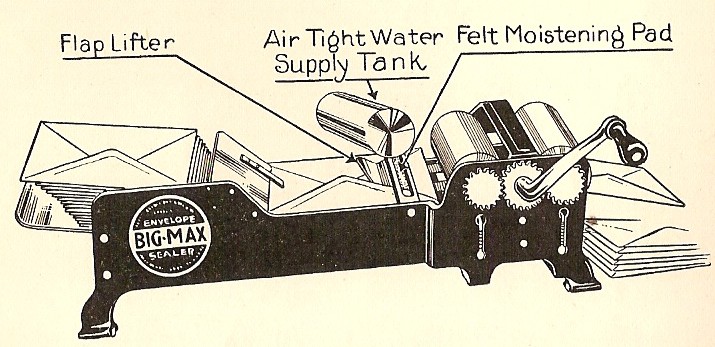| Antique
Mail Room Equipment |
Antique Mail Room
Machines

"Heap of Papers," Denver, CO,
photograph by Harry M. Rhoads (1880/81-1975)
Denver Public Library, Western History Collection (00186429)
This exhibit traces the mechanization of the
office mailroom, which occurred largely between the late1890s and World War I. The key
developments involved machines that addressed items to be mailed and that
sealed, affixed postage to, and opened envelopes..
| |
Photos
Click to enlarge |
| Addressing Machines
Addressing machines are used to print names and addresses on newspapers, mailing
labels, envelopes, form letters, and other items. The earliest
addressing machines appear to have been used by publishers of periodicals,
among others. These machines
eventually led to a considerable savings in clerical labor for other companies
with large mailing lists, such as insurance companies and companies that used direct mail advertising.
The earliest known patent for an addressing machine was awarded to a
Canadian, Robert Dick, in 1859. An illustration from the 1859 patent is
reproduced top right. Patents for improvements on Dick's machine were
awarded to William H. Clague and Robert B. Randall in 1871, Elias Longley in 1875, and
Dick in 1875, 1884, and
1889. 1894, 1899, and 1908 patent dates also appear on this type of
machine. This patent history indicates that this type of machine was marketed for at least
50 years. The second photo to the
right shows a machine based on the 1875 Longley patent that was made by
the Mather M'F'G. Co., Philadelphia.
According to the 1859 Dick patent, a user of his addressing machine was
expected to use a printing press to print columns of names and addresses
on sheets of paper. In 1861, the Michigan Farmer reported
that "We have procured one of the celebrated Dick's Addressing
Machines in order to facilitate mailing the Farmer. By it,
accuracy, as well as dispatch, is secured. Putting in type over two
thousand names to be used in this machine has delayed the issue of the Farmer,
but we feel confident that our readers will bear with us a little, while
making these important improvements." (Michigan Farmer,
Oct. 5, 1861) The individual columns of names and addresses
were then cut apart and glued together end to end to form a roll. The roll was
put on a spool in the back end of the addressing machine (the end to the
left in the first image in the column to the right). The
paper was fed through a number of rollers, which moved the paper through a
tank containing liquid adhesive, and then to a cutter at the front of the
machine. The machine was placed on a stack of envelops, newspapers,
or other items to be addressed. When the first name and address came
out of the machine, it was cut off the roll and at the same time pressed
onto the top envelope. That envelope was removed, and the process
continued. The patent claimed that two people with one machine could
address 4,000 items per hour. Dick proposed that the same technology
could be used to produce account statements that could be attached to
cards and mailed.
An article in the Circular in 1867 describes an addressing machine
used by the Circular. The machine was manufactured by C. M.
and S. Peck, New Haven, CT, under patents issued to Wright and Peck and H.
Moeser. According to the article, "The writing involved in mailing of
even less than 2000 papers sent weekly from the office of the Circular
was, a few months since, no easy task. Now a person sits down to a
machine and, in a small proportion of the time it formerly took to write
the names and post-office directions, makes sport of printing
them It may interest some who have never seen the operation to
learn more particularly how it is performed. The machine is furnished with
a small case of steel matrices or dies, resembling common type, excepting
that the letter on the die is sunk into the metal. The name of each
subscriber is 'set up' with the matrices in a composing-stick, and is
transferred to a wooden block by means of a small lever-press, which with
a single stroke leaves all the letters of the same standing in relief upon
the end of the block. The address blocks are placed upon
galleys. The galleys when filled and locked up are ready to be inked
and passed through the gallery-race of the addressing machine. A
galley is pushed forward in the race until the first name is seen through
the aperture in the shield plates, where it is firmly held by a
friction-brake. The newspaper to be directed is laid over the
opening between the shields, when the operator, by pressing with his foot
on the treadle, brings a small platen down upon the paper, [and] forces it
upon the inked block below. The return movement of the treadle
brings forward another name. Of course, after all the address-blocks are
once made, they may be used for a long period. Other
addressing-machines have been invented which involve no transfer of the
names to wooden blocks, but depend upon standing type." (Circular,
June 17, 1867)
A number of other addressing machines were patented during the 1870s and 1880s,
including ones by McFatrich (1870), Darling (1873), Edison (1877), Belknap
(1877), and
Dennis and York. Leffingwell (1926) reports that "a patent was issued to
James McFatrich, of Lena, Illinois, on October 4, 1870, for a machine
called the 'McFatrich Mailer' which was, so far as is known, the first
addressing machine. [Evidently, Leffingwell was not aware of the Dick
machines.] Securing a license from the inventor, the Shniedewend
& Lee Company, of Chicago, manufactured the mailer during the full
term of the patent, beginning in 1880. This company was succeeded by the
Challenge Machinery Company, in 1893. The name was changed to the
Mercantile Addressing Machine Company. McFatrich was not alone in
this pioneering, for in 1877 Frank D. Belknap, of Wooster, Ohio, made an
attempt to get away from hand addressing. He wrote the names and addresses
on a sheet of parchment paper with an electrically operated pen and
obtained additional addresses by passing an inked roller over several
sheets of parchment containing the master addresses, the envelope or
matter to be addressed being placed under the sheet. When the typewriter
came into commercial use, parchment paper, instead of being used in long
strips as in the earlier models, was cut into individual pieces and pasted
to a cardboard frame, thus making the first addressing machine
stencil. These stencils were inserted into the typewriter, one at a
time, and the name and address cut into the paper by the needle-point type
with which the early stencil-cutting typewriters were equipped. The
stencils were then fed through the addressing machine and the envelope
addressed, the outline of the letters being dotted." (W. H.
Leffingwell, The Office Appliance Manual, 1926, pp. 406-07) According to a 1924 account, "The original addressing machine invented in 1878 by Frank Belknap,
now the Rapid Addressing Machine Company [which was founded by Belknap in
1885], was designed as an aid in
addressing envelopes. The characters were cut on a strip of paper.
Perforations on the side, similar to the perforations on the film for
moving pictures, afforded a means of drawing the strip through the
machine. Later, separate cards made up of a piece of parchment paper
pasted to a cardboard frame were used." (The American Digest of
Business Machines, 1924.)
In 1889, small manual printing presses, such as the Patent Lever
Self-Inker Press No. 2 pictured to the right, were promoted as envelope
addressing machines. According to Scientific American (May 4,
1889), Smith's Patent Lever Self-Inker No. 3, made by the R. H. Smith Mfg.
Co., Springfield, MA, is "especially designed for printing the
addresses on envelopes, postal cards, and shipping tags, which it does
rapidly and in a most perfect manner, using metal-bodied rubber-faced
type, and the office boy can in his leisure moments set up the addresses
and print a complement of envelopes for each of the firm's regular
correspondents."
 The
Couch Automatic Addresser was marketed in 1890. According to a
product review, "It is almost the size of a type-writer. By
inserting the postal card or envelope immediately under the stamp above
the cylinder, as shown in the cut [see image to right], and giving the
stamp a light blow, the name and address is plainly and nearly printed,
and at the same time the cylinder is revolved automatically to the next
[name and address]. The name and address of each correspondent are
stereotyped and then cut into slugs, each being made to fit into the
dove-tailed grooves in the cylinder." The
Couch Automatic Addresser was marketed in 1890. According to a
product review, "It is almost the size of a type-writer. By
inserting the postal card or envelope immediately under the stamp above
the cylinder, as shown in the cut [see image to right], and giving the
stamp a light blow, the name and address is plainly and nearly printed,
and at the same time the cylinder is revolved automatically to the next
[name and address]. The name and address of each correspondent are
stereotyped and then cut into slugs, each being made to fit into the
dove-tailed grooves in the cylinder."
"In 1890, another inventor, Walter E. Crane, brought out a
keyboard machine which embossed names and addresses on paper and metal.
Thin brass was used. The thin brass was in continuous long strips. To
print the addresses, the continuous strips of brass were run over a drum
on high-speed addressing machines." (Leffingwell, pp. 407-09.)
 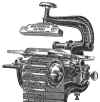 "In 1892, Joseph S. Duncan, now President of the Addressograph
Company, invented a machine that imprinted names and addresses from rubber
type glued on a block of wood. He later designed a metal frame in which
might be set individual pieces of rubber type. Later came the Graphotype,
a machine for embossing type on metal plates." The earliest
advertisement that we have found for an Addressograph machine dates from
1896. The ad states that the machine could address 2,000
envelopes per hour. The ad shows the machine (left, with enlarged detail
to right), which bears an
1896 patent date. The address plates, which were
connected to form endless chains, appear to use rubber type. "In 1892, Joseph S. Duncan, now President of the Addressograph
Company, invented a machine that imprinted names and addresses from rubber
type glued on a block of wood. He later designed a metal frame in which
might be set individual pieces of rubber type. Later came the Graphotype,
a machine for embossing type on metal plates." The earliest
advertisement that we have found for an Addressograph machine dates from
1896. The ad states that the machine could address 2,000
envelopes per hour. The ad shows the machine (left, with enlarged detail
to right), which bears an
1896 patent date. The address plates, which were
connected to form endless chains, appear to use rubber type.
The use of rubber type in 1896 is consistent with the fact that the
earliest patent date on the Graphotype, the machine that was used to
emboss letters on metal address plates, was 1899. On a standard Graphotype, a letter was dialed and then a
handle was pulled to emboss that letter on a metal plate.
In 1899, Addressograph
advertised the foot-powered No. 2 addressing machine, which was similar in
appearance to the 1896 machine pictured to the
left, for
use with metal plates connected to form continuous chains. The price was $40. The
No. 2, or a machine very much like it, was still advertised during 1902
and 1903. In 1903, an ad claimed that the machine could print 3,000
envelopes, tags, checks, etc., per hour. The same ad claimed that
11,000 merchants were using Addressographs.
In 1906, attachments were available so that the Addressograph could print
addresses on various types of form.
We have seen an 1893 advertisement by Blackner Bros. & Co., Chicago,
IL, for the Perfect Envelope Addresser, with a claim that it would print
1,500 names per hour on envelopes, postal cards, etc. This ad does
not include an illustration.
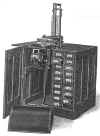 In 1907, Addressograph
offered In 1907, Addressograph
offered  Card Index Addressographs that printed addresses using separate
plates that were loaded in a vertical hopper. These machines, one of which
is pictured to the left, were $73 including an oak cabinet. Immediately
to the right is a picture of one of the metal plates. Card Index Addressographs that printed addresses using separate
plates that were loaded in a vertical hopper. These machines, one of which
is pictured to the left, were $73 including an oak cabinet. Immediately
to the right is a picture of one of the metal plates.
In 1907, the Addressograph Co. advertised "30,000 Addressographs in
Use."
In 1913, it claimed that 40,000 entities used its machines. (System, Oct. 1913).
Until at least 1910, Addressograph offered two types of address printing
machines, ones that used plates with sliding rubber type and others that
used embossed metal plates.
While the first Graphotype patent dates from 1899, initially customers
using metal address plates may have been required to have the addresses
embossed on the plates by the Addressograph Co. However, by 1910,
Addressograph was selling its Office Graphotype. According to a 1910 ad,
"The Office Graphotype is an electric motor driven machine for
stamping addresses on metal plates. It was designed especially for users
of the Metal Card Index System." The machine was $350. An illustration is provided
below. An
Addressograph machine is pictured in the 1911 catalog of Hesser Business
College, Manchester, NH.
Eventually, Addressograph offered hand and
electric-powered addressing machines to print addresses, as well as
foot-powered models. In 1924, Addressograph printing machines ranged from $37.50 for a hand-operated model that could print about 1,000 addresses per hour,
and $190 for a foot-operated machine, to $1,500
for a large automatic-feed electric machine that could print 9,600 addresses
per hour. Hand operated Graphotypes were $145 to $260, electric models were $395 to $460,
and the keyboard model was $850.
Graphotype and Addressograph Machines, c. 1910-1924
|
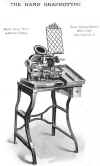
Hand Graphotype
|
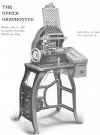
Office Graphotype, 1910
|
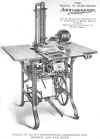
Model B Card Index Addressograph
|
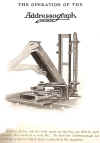
Operation Step 1
|
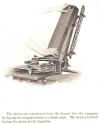
Operation Step 2
|

Operation Step 3
|
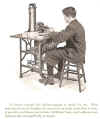
|
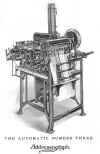
Automatic Number Three, 1923
|
Source of preceding row of images: Museum
of Business History and Technology
A number of companies in addition to Addressograph produced hand-operated, foot-powered, and
electric addressing machines in the early 20th century. Additional brands marketed during
1902-25 were
the Addressall, Belknap/Rapid, Elliott, Meacham, Montague/Direx-All,
Rogers, Standard, and Velox. Some of these machines
used metal plates like those used with the Addressograph, while others
used fiber stencil address cards. In 1915, the Montague Mailing Machinery Co, Chattanooga, TN, offered 20 types of addressing machines for $15 and up. A very simple stamper, which had an output of 300-500/hr, was $15. The desktop Type C, output of 1500/hr, was $37.50. Type N, output 2000-3000/hr, $150. Type F, output 3000-4000/hr, $250-$360. (System, Jan. & Mar. 1915.)
Belknap Addressing Machines, 1902, 1915
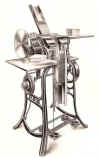 |

Belknap Rotary Rapid Addressing Machine, 1902 ad
Source of left and right images:
Museum of Business History and Technology |
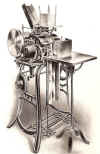
Belknap Rotary Rapid Addressing Machine |
| . |

Belknap Rotary Addressing Machine
Rapid Addressing Machine Co.
This machine used stencils.
1915 Price $57.50. Ten other models priced up to $1500. (System, Mar. 1915.)
|
. |
"In 1897 Sterling Elliott devised an addressing system. His
machine embodied principles of construction and operation not found in the
others. It was designed primarily for his private use and was not
marketed until 1900." (Leffingwell, p. 410.) The Elliott Addressing Machine Co. introduced fiber address
stencil cards during the first decade of the 20th century. Addresses were cut on the fiber cards using a
standard typewriter or a stenciling machine. To print
addresses, ink was forced through the stencil cards. (The American Digest of
Business Machines, 1924)
Elliott Stenciling and Addressing Machines, 1905 and
1920s
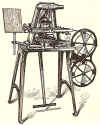
Elliott Stencil Cutting Machine, 1905. 1906 Price $150. |
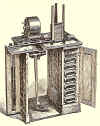

Left: Elliott Addressing Machine, 1905. 1906 Price $65.
Right: Cabinet
for Stencils for Elliott Addressing Machines, 1906 ad |

Elliott Hand Stenciling Machine, 1920s |

Elliott Electric Stenciling Machines, 1920s |

Elliott Hand Cranked Addressing Machine, 1920s |
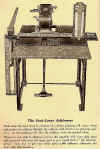
Elliott Foot-Lever Addresser, 1920s |
In 1913, Hillard Mfg Co., NYC, advertised its Meacham Addressing Machine, which appeared comparable to the 1902 Belknap machine above left and which used silk stencils that were cut on a regular typewriter. This could be used to fill addresses that matched typewriting into form letters.(System, Sept. 1913.)
In 1914-15, Elliott advertised its hand, foot,and electric powered addressing machines, which had output rates of 1500, 3000, and 4000 addresses/hr, for $35, $90, and $185, respectively. (System, Jan. 1915) In 1917, the price range was $50 to $200. In 1924, the price range was $35 for a hand model to $500 for an automatic feed model.
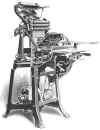 In 1907, Addressograph was marketing its Dupligraph machine (pictured
right), "the highest development of the process of producing
imitation typewritten letters." The machine simultaneously printed
the text of a letter (prepared using sliding type), a name and address
(using an Addressograph plate), a choice of salutation (Dear Sir or
Gentlemen), and a signature (in a different color ink), all at the rate of
800 to 1,200 per hour. In 1927, American Multigraph introduced the Addressing
Multigraph, which used metal plates to print addresses and form letters
simultaneously. In 1907, Addressograph was marketing its Dupligraph machine (pictured
right), "the highest development of the process of producing
imitation typewritten letters." The machine simultaneously printed
the text of a letter (prepared using sliding type), a name and address
(using an Addressograph plate), a choice of salutation (Dear Sir or
Gentlemen), and a signature (in a different color ink), all at the rate of
800 to 1,200 per hour. In 1927, American Multigraph introduced the Addressing
Multigraph, which used metal plates to print addresses and form letters
simultaneously.
In 1930, the Addressograph International Corp. acquired the
American Multigraph Co. In 1931 the name of the merged firm was
changed to the Addressograph-Multigraph Corp. In 1979, the company
name was changed to AM International Inc. AM International was still
operating in 1985. The following two photographs were
taken at an Addressograph sales outlet in 1929. The first shows a
room with ten Addressograph machines of various types, including three
Graphotype machines. The second shows a shop with men working on two
Addressograph machines. In the latter photo, the machine on the left
is a desktop manual Addressograph attached to a work stand. The
machine on the left is labeled Automatic Envelope Feed Addressograph. 

Addressograph Machines, 1929
|
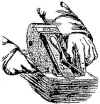
Dick addressing machine, 1859. This illustration
shows the machine atop a stack of papers. "A" identifies
the paper column of addresses as it emerges from the tank of liquid
adhesive inside the machine. "D" identifies the cutter that is
pivoted down to cut off one address at a time and press it onto the top
paper.

Longley addressing machine, 1875, serial no. 918. The vertical bar in
the middle of the photo is the cutter. The item to the right is the tank
for liquid adhesive. This tank, which appears to be handmade, fits
into the machine.

Dick addressing machine, 1889 patent model.
Courtesy of Barry Baldwin.
For sale on his website,
Patent Models from the 1800s

Mustang Mailer, 1883 ad

Patent Lever Self-Inker Press No. 2, 1889 ad

Graphotype Model 6142, patented 1917
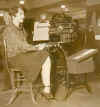
Woman with Keyboard Electric Graphotype at 24th National Business Show,
1927

Hand-Operated Addressograph Model H3, Patented
1904-12

Office with Electric Addressograph (left) and Graphotype, Washington, DC,
c. 1922, detail.
Lib. of Cong., Prints and Photographs Div., LC-USZ62-111333

Elliott Addressing Machine
Courtesy of Martin Howard Collection
www.antiquetypewriters.com

Elliott Hand Crank Rotary Addresser, 1920s-1930s
|
Envelope Sealers
Beginning around 1900, a large variety of small devices and
larger machines were marketed for use in sealing envelopes. A number
of images of Standard Envelope Sealers are presented immediately below,
and images of a number of other envelope sealers are presented to the
right.
Sealograph and Standard Envelope Sealers, 1912-1930

Sealograph Model A
Hand Power, c. 1912 |

Sealograph Model B
Electric Hand Feed, c. 1912 |
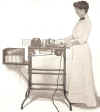
Electric Sealograph. Image appears in System, Oct. 1913. |
Image
coming H
Standard Envelope Sealer Model C
c. 1916-27.
Image coming
Standard Envelope Sealer Model F $25 1915
The ad claimed that Model F had an output of 6000-9000/hr.
(System, Mar. 1915) |

Standard Envelope Sealer
Model F., advertised 1930
Courtesy of Martin Howard Collection
www.antiquetypewriters.com
|

Standard Envelope Sealer Model H, patented 1914-18, advertised 1930 |
Source of three images above left: Museum
of Business History and Technology
Standard Envelope Sealers were put on the market in 1914. In March 1915, an ad stated "More than 6,000 Standard Sealers sold in the first eight months after being put on the market."
Advertisements for Envelope Sealers
| Year
Advertised |
Machine
Name |
Manufacturer |
Source
and information about machine. |
| 1899 |
Pletcher
Envelope Moistener and Sealer |
Benj. F.
Pletcher, Lock Haven, PA |
BK97
(small $1) |
| 1902-03 |
Thexton Electric Envelope
Sealer
|
Thexton Electric Envelope Sealer Co.,
Chicago, IL. |
BK43,
BK0603p.145 ($50)
Add image. |
| 1904 |
Thexton Junior Envelope
Sealer |
Thexton Electric Envelope Sealer Co.,
Chicago, IL |
BK04 ($15, non-electric) |
| 1904-05 |
Thexton Envelope Sealing
Machines |
Acorn Brass Mfg. Co., Chicago, IL |
BK04.929 ($15-$50),
Beach 1905 |
| 1903-04 |
Eureka Envelope Moistener and
Sealer |
Eureka
Novelty Co, Boston, MA |
BK03&04
(small, $0.50).
Beach 1905 |
| 1905 |
Shermac Universal Envelope
Sealer |
Hall Office Specialty Co., Chicago,
IL |
BK05.1078 ($5),
Beach 1905 |
| 1905 |
Cleveland
Envelope Sealer and Stamper |
Cleveland
Envelope Sealer Co, Chicago, IL |
Beach 1905 |
| 1905
1907 |
Addressograph
Envelope Sealer
Addressograph "Junior"
and "Senior
Electric" Envelope Sealing Machines
|
Addressograph
Co., Chicago, IL |
Beach 1905,
sealed 3000 to 7000 envelopes per hour
Junior $20,
Senior Electric $60. |
| 1905 |
Elliott
Envelope Sealer |
Elliott
Addressing Machine Co., Boston, MA |
Beach 1905 |
| 1905 |
Hunt Stamp
and Envelope Moistener |
F. P. Hunt
Co., New York, NY |
Beach 1905
{Small device. Good illustration] |
| 1906 |
American Envelope
Sealer |
American Sales & Mfg Co, Kansas City |
(small hand gadget) |
| 1906 |
Perfect Envelope
Sealer |
A.T. Kline
Mercantile Co., Somerville, NJ |
See image to
right |
| 1907 |
Hasty Envelope
Sealer |
A.T. Kline
Mercantile Co., Somerville, NJ |
. |
| 1908 |
Richissin
Envelope Sealer, patented 1907 |
. |
Tower p. 37
(small) |
| 1908-10 |
Simplex Automatic Envelope Sealing
Machine |
Simplex Mfg. Co., New
York, NY |
S1008, S1208 (large electric), A. Pomerantz & Co cat. 1910
($165). See image to right. |
| 1908 |
Automatic Envelope Sealing & Stamping
Machine |
Automatic Envelope
Sealing & Stamping Machine Co, Providence RI |
(large machine, seals,
stamps and counts letters) S1208. |
| 1909 |
Packer Envelope
Sealer |
B. E. Del Camp, Chicago, IL. |
($2) |
| 1910 |
Saunders Envelope
Sealer |
Saunders Sealer Co., Cleveland, OH |
($2) |
| 1912-22 |
Reynolds Envelope
Sealer, patented 1910 |
. |
Horder's Catalog (1922) p. 184.
See photo to right. |
| 1912 |
Sanitary Envelope Moistener &
Sealer |
. |
Binney & Smith Co NY p.
11 |
| 1913 |
Roco Envelope
Sealer |
G. E. Stimpson Co, gen agents, Worcester, MA |
$10. S1013 |
| 1913 |
Novelty Envelope
Sealer |
Office Appliance Mfg. & Novelty Co., NY, NY & Pittsburgh, PA |
$10.
S0913 |
| 1913 |
Office Boy Envelope
Sealer |
Borger Mfg. Co., Cleveland, OH |
$15.
S1113 |
| 1913-14 |
Sealograph |
Saunders & Co., Kansas City,
MO |
Model A (hand power)
and Model C (electric power) S0314 |
| 1914 |
Pence Mailing
Machine |
Pence Mailing Machine Co., Minneapolis,
MN |
Large machine. Seals and affixes stamps on 6,000 envelopes per hour.
Literary Digest 091414. |
| 1914-24 |
Acorn-Thexton Envelope
Sealer |
Acorn Brass Mfg. Co., Chicago,
IL |
"O.K'd by 10,000...businesses." S0315. $27.50-$80 S0315, S0917-S1217. |
| 1915 |
Red Square Envelope Sealer |
Red Square Co., NY, NY |
Hand crank, $25 S0315. |
| 1916-30 |
Standard Envelope
Sealer, patented 1914-18 |
Standard Envelope Sealer Mfg. Co.,
Somerville, MA |
Model C $15-$25 S0917-1217. |
| 1917-18 |
Kendall Envelope Sealer, Kendall Mfg. Co., Boston, MA |
. |
(small hand
gadget) |
| 1922 |
Graywood Envelope
Sealer |
Graywood Mfg Co., Lynn, MA |
(similar to 1924
Elliott) |
| 1924-39 |
Elliott Envelope Sealer |
. |
$45 in 1924.
See photo to right |
| . |
Standard Postal
Permit Printer and Sealer |
Standard Mailing Machines Co., Everett, MA |
Affixed and postmarked stamps to
envelopes and counted and sealed the envelopes. |
|



Perfect Envelope Sealer ( a.k.a.
Eagle Safety Envelope Fastening and Sealing Press, Cachet Crampon)
Advertised in U.S. 1906 (Perfect), France in 1913, and U.K. 1920s (Eagle). Sold by Blanzy Poure & Cie
Boulogne sur Mer, France (Cachet Crampon)

Thexton Electric Envelope Sealer,
1903 ad
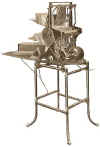
Simplex Envelope Sealer, 1908 ad

Reynolds Envelope Sealer,
patented 1910

Elliott Envelope Sealer,
c. 1924-39

Bruce Envelope Sealer, Framingham, MA, Patent Number 1,837,156,
Dec. 15, 1931.
|
| Stamp Machines
Stamp Affixers
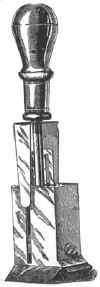 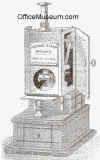 Stamp affixers served two purposes. First, they
mechanized the process of affixing stamps to letters. Second, they made it
more difficult for employees to steal stamps. The image to the left shows
the Postage Stamp Affixer marketed by Wm. H. King in 1890. A 1900 ad claimed
that the Klein Stamp Sticker, which was patented in 1899, had a capacity of 300 stamps and moisture for
2,000 stamps. The illustration [coming] shows that the stamps were
stacked vertically inside the machine. The Alert Post Stamp Machine was
advertised in 1905. Stamp affixers served two purposes. First, they
mechanized the process of affixing stamps to letters. Second, they made it
more difficult for employees to steal stamps. The image to the left shows
the Postage Stamp Affixer marketed by Wm. H. King in 1890. A 1900 ad claimed
that the Klein Stamp Sticker, which was patented in 1899, had a capacity of 300 stamps and moisture for
2,000 stamps. The illustration [coming] shows that the stamps were
stacked vertically inside the machine. The Alert Post Stamp Machine was
advertised in 1905.
Stamp vending machines were introduced shortly
after 1900. Initially, private companies made coils of stamps from sheets
issued by the government. The US Post Office began to issue coils in 1908,
and shortly after that a number of companies began to market stamp
affixing machines that used coil stamps.
The White Stamp Affixer, which was advertised during
1910-16, was a desk-top machine. The National Stamp Affixer (pictured to
the right) was another desk-top machine. The Automatic Envelope Sealing
and Stamping Machine, which was advertised in 1911, sealed and stamped
5,000 to 8,000 envelopes per hour, using coils of stamps purchased from
the post office.
The Multipost Stamp Affixer &
Recorder, a smaller handheld device made by Multipost Co., Rochester, NY, was patented in 1911 and advertised from 1910 to 1940. There were two models at $15 & $25. A 1915 ad stated that there were 20,000 users. (System, Mar. 1915.)
The Kendall, Postamper, Simplex, Standard, and Wizard stamp affixers, which were advertised during
1912-27, were similar to the Multipost. In 1915, the Postamper was $25 and the
wizard was $12.50. (System, Mar. 1915) One difference between the lower and higher priced models seems to have been the amount of data recorded. According to
a Postamper ad, "One stroke of the plunger affixes the stamp and also counts it. A
measured drop of water moistens the envelope and a rubber cushion presses
the stamp to the moistened surface. Double lock safeguards your stamps.
One for the cashier who puts in the stamps--the other for the operator, so
that no stamps can be taken without his knowledge."
Stamp Perforators
"The Cummins Stamp Perforator prevents all thefts of
postage stamps. This method was authorized by Postmaster General
Meyer's ruling of May 4th, 1908, as follows: 'It shall be permissible to
puncture or perforate letters, numerals or other marks or devices in the
Unites States postage stamps. The punctures or perforations shall
not exceed one thirty-second of an inch in diameter.'" (System,
Oct. 1908)
Metered Mailing Machines
In 1920, several years after Pitney invented a postage meter, Congress
approved metered mail. Pitney-Bowes
introduced the first postage meter and permit printing machine in 1921.
The machines not only printed pertinent postal information on envelopes but
also sealed the envelopes. "Metered permit mail is imprinted with the mailer's
license and meter number, together with the postmark. This operation is
performed simultaneously with the sealing by a permit printing machine.
The meter is a detachable portion of such machines and it is taken to the
post-office where it is set by the postmaster for the amount of postage
desired, which is paid for at that time. It locks when this amount has
been used." (Office Equipment Catalogue, 1927, pp. 71-72) The
first Pitney-Bowes machine, the Model A, sold for $1,350 and leased for $10 a month. The second, introduced in
1924, sold for $735. Because the equipment was expensive, in the 1920s use
of Pitney-Bowes machines was limited to companies and other organizations
that sent a large number of letters. During 1921-27, 2,849 Pitney-Bowes
machines were installed. (W.
Cahn, The Story of Pitney-Bowes, 1961, pp. 66-67, 81.) By 1927, the
International Postal Supply Co. was marketing Sealometer postage metering
and sealing machines in competition with Pitney-Bowes. In 1930,
Pitney-Bowes introduced its Model H, a desktop postal meter and printing
machine that did not seal letters. The Model H was $75.
Non-Metered Permit Mailing Machines In the 1920s, there was also
"non-metered permit mail" in the US. A company printed its
permit number and a postmark on letters using a machine that did not have
a meter. Payment for postage was made when the mail was delivered to the
post office. Pitney-Bowes mailing machines could be used for metered
permit mail or, without a meter, for non-metered permit mail. In 1924-27, the Standard Envelope Sealer Mfg.
Co. advertised the Standard Postal Permit Printer and Sealer. The
machine, which did not have a meter, automatically fed and sealed
envelopes and printed the permit information. In 1924, this machine was $675. |
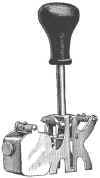
Alert Post Stamp Machine, 1905 ad

National Stamp Affixer
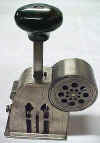
Multipost Stamp Affixer & Recorder, Patented 1911, Advertised
1910-40

Cummins Stamp Perforator,
B. F. Cummins, Chicago, IL, 1908 ad
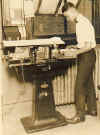
Pitney-Bowes Model A Permit Printing Machine.
The Model A was the first Pitney-Bowes machine. It was still marketed
in 1927.
|
Envelope Openers
1884 A. B. See Letter Opener, R. R. Watson, New York, NY, $2.50 ("This
delicate instrument cuts the end off the envelope in an instant, thus
exposing the contents." $2.50)
1912 Simplex Letter Opener, Binney & Smith Co NY
1914-28 Ries O. K. Letter Opener, O.K. Mfg. Co., Syracuse, NY (1914). 1915 Prices $12, $15, $18 for 3 sizes. Oswego NY (1928)
1914-20 Lightning Letter Opener, Lightning Letter Opener Co., Rochester, NY
(1914), The Bircher Co., Inc., Rochester NY (1920)
1922-25 Mihill Envelope Opener, Horder's (1922), Grammes (1925) |
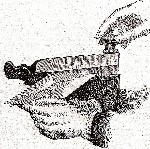
A. B. See Letter Opener, 1884 ad

Ries O.K. Letter Opener, Patented Oct. 17, 1911, also 1919.

Lightning Letter Opener, Patented 1912-18
|
Folding Machines
Machines that folded letters came into use around 1907.
1907 Adams Folding Machine, Adams Folding Machine Co., Minneapolis, MN
(folds letters)
1908 Universal Folding Machine, Universal Folding Machine Co, Chicago, IL.
S1008, S1208
1908 National Folding Machine, National Folding Machine Co., Sidney, OH
S1208
1910 Van Etten Circular Folder, Van Etten Machine Co, Sidney, OH.
1921 Gammeter Multigraph Folder, Gammeter Multigraph Co., Desborough.
1923-25 Multigraph Folder Junior, American Multigraph
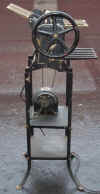 Multigraph Folder No. 58, American Multigraph Corp., Cleveland, OH
Multigraph Folder No. 58, American Multigraph Corp., Cleveland, OH |
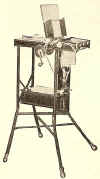
Adams Folding Machine, Adams Folding Machine Co.,
Minneapolis, MN, 1907 ad.

Universal Folding Machine, Universal Folding Machine
Co., Chicago, IL, 1908 ad.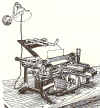
Gammeter Multigraph Folder, 1921 ad; same a s the Universal Folding Machine
above |
|
Parcel Labeling Equipment
Stencils were used to label shipping crates by 1860.
The images to the right show: (1) An example of a custom made stencil that
could be ordered by mail by 1860. (2) A general purpose stencil that could
be used to label a box with letters and numbers or letters only. (3) A hand stencil cutting
outfit.
The last image to the right shows a Holt's Patent Marking Wheel, a
self-inking rotary rubber stamp that was used to print the sender's name
and address on parcels.
In 1868, Dennison & Co. received a patent for and was selling
cardboard shipping labels,, including ones with attached strings.
Buyers had the option of having Dennison & Co. print them to order.
The images below show two rotary stencil cutting machines and a linear
stencil cutting machine. Stencil cutting outfits and machines were
used to cut
paper stencils used to label boxes.


Diagraph Improved Stencil Cutting Machine, American Diagraph Co., St.
Louis, MO.
A similar model was offered in 1905.
(Add 1908-13 advertising image.)
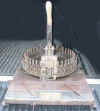
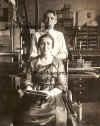
Above Top: Bradley Stencil Machine, Bradley Stencil Machine Co., St. Louis, MO,
patented 1893-98
Above Bottom: Office with Bradley Stencil Machine (center right)


Top: Bradley Stencil Machine, Bradley Stencil Machine Co., St. Louis, MO, patented 1893-99, introduced 1898,
A. J. Bradley, NY, NY, 1915 ad
Bottom: Photo right courtesy of Jim Brown
The Marsh Stencil Cutting Machine was advertised by Horder's Inc. in 1928.
|

Custom-made stencils of this type could be ordered by mail by 1860

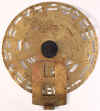
Revolving Stencil Letters & Figures, patented 1868-71, still advertised
1928

Stencil Cutting Outfit, New York Stencil Works

Holt's Patent Marking Wheel, Secombe Manufacturing Co., New
York, NY, patented 1866, advertised 1870. This roller, which
had rubber type, was used to print manufacturers' and distributors' names
and addresses on packages.
|
| Postal Scales
The UK introduced both postal rates based on weight and adhesive postage stamps in 1840. Other countries soon followed,
and as a result there was a market for letter scales. The photographs in the column to the right show
two styles of letter scales that
were introduced around 1840. The top one is a candlestick spring scale of
a type that was marketed until the 1870s. Below that is an English
Roberval balance scale of a type that was marketed until around 1940.
  The
images to the left and right show two Perfection Postal Scales,
While these scales were reportedly manufactured by the Perfection Scale
Co., Cortland, NY, the one to the left has the following on its front:
"Automatic Perfection Postal Scale, American Machine Co., Philada."
It also has an 1868 patent date. An 1892 product review stated that
"The Perfection Postal Scales have been adopted for use in the postal
service of the United States. They are becoming quite generally used
in banks, insurance and railroad office and in the better class of
manufacturing and mercantile houses throughout the country." The
images to the left and right show two Perfection Postal Scales,
While these scales were reportedly manufactured by the Perfection Scale
Co., Cortland, NY, the one to the left has the following on its front:
"Automatic Perfection Postal Scale, American Machine Co., Philada."
It also has an 1868 patent date. An 1892 product review stated that
"The Perfection Postal Scales have been adopted for use in the postal
service of the United States. They are becoming quite generally used
in banks, insurance and railroad office and in the better class of
manufacturing and mercantile houses throughout the country."
  To
the left is a Fairbanks letter balance scale of a type that was patented
in 1876 and advertised by 1878. To the right is an 1883 ad for a
Fairbanks post office package scale. The same image appeared in a 1910 office supply catalog offers this machine. Fairbanks began to manufacture scales (not postal scales) in 1830.
To
the left is a Fairbanks letter balance scale of a type that was patented
in 1876 and advertised by 1878. To the right is an 1883 ad for a
Fairbanks post office package scale. The same image appeared in a 1910 office supply catalog offers this machine. Fairbanks began to manufacture scales (not postal scales) in 1830.
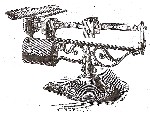 To
the left is an 1884 ad for an R. R. Watson Postal Balance. To
the left is an 1884 ad for an R. R. Watson Postal Balance.
Montgomery Ward's 1894-95 mail order
catalog advertised a Victor letter balance with the same design as the
Roberval scale in the photo to the right. Scales of this type were advertised
in Germany in 1910 and France in 1913.
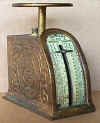 Spring
balance scales were advertised by the Gilfillan Scale & Hardware Spring
balance scales were advertised by the Gilfillan Scale & Hardware  Co.
in 1895 (see ad to right) and marketed in 1897 and for decades after that by the Pelouze Scale and
Mfg. Co. The model in the Zodiac pattern to the left was marketed by
Tiffany Studios of New York in the late 1890s and early 1900s. Co.
in 1895 (see ad to right) and marketed in 1897 and for decades after that by the Pelouze Scale and
Mfg. Co. The model in the Zodiac pattern to the left was marketed by
Tiffany Studios of New York in the late 1890s and early 1900s.
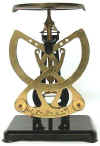 To the
left is a bilateral pendulum scale of a type that was patented in
Germany in 1904 and advertised in Germany in 1908-10, the US in 1910, and France in 1913. To the
left is a bilateral pendulum scale of a type that was patented in
Germany in 1904 and advertised in Germany in 1908-10, the US in 1910, and France in 1913.
For photographs of a number of additional styles of early
postal scales, click on the following links to visit the exhibits at the Canadian
Postal Museum and Scales
& Weights.
|
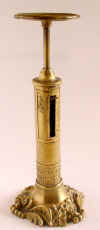
Candlestick spring scale, Jos. Edm. Ratcliff, UK. The candlestick scale
was introduced in 1840. A similar Spring Pillar Balance was
advertised in 1855.

Roberval balance scale, England, style introduced 1840.
Similar scales advertised 1855 & 1878, and in France in 1913.
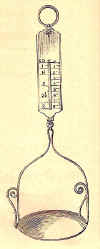
Letter Balance, 1883 ad
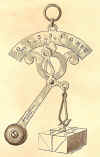
Peerless Letter Scale, Marshall Son & co., Boston, MA, 1883 ad.
A similar scale was advertised in France in 1913.
|
Tape and Label Moisteners & Dispensers
Mail rooms in the late 1800s and early 1900s were equipped with
a variety of stamp, envelope, label, and tape moisteners as well as
pasting machines.
1907 Universal Pasting Machine, Chas. Beck Paper Co., Philadelphia, PA.
1912 Universal Pasting Machine, Binney & Smith Co NY p. 22
1912 Jiffy Gummed Tape Machine, Binney & Smith Co NY p. 43
1922 Liberty Tape Moistener, Horder's p. 184
 1918 Star No. 6 tape dispenser. Also advertised by Horder's Inc. in 1928.
1918 Star No. 6 tape dispenser. Also advertised by Horder's Inc. in 1928. |

Glass Dampener, 1881 ad. The same image was used in a 1910 office supply catalog that offered this item, and a similar if not identical item was offered in the 1928 Holder's Inc. catalog.


Labelor Model 101, Better Packages, Inc., Shelton, CT

Universal Pasting Machine, Chas. Back Paper Co., Philadelphia, PA, 1907
ad. |
|

 Multigraph Folder No. 58, American Multigraph Corp., Cleveland, OH
Multigraph Folder No. 58, American Multigraph Corp., Cleveland, OH


 1918 Star No. 6 tape dispenser. Also advertised by Horder's Inc. in 1928.
1918 Star No. 6 tape dispenser. Also advertised by Horder's Inc. in 1928.




